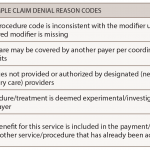WASHINGTON (Reuters) – Democratic presidential front-runner Joe Biden and rival Bernie Sanders are waging a public battle this week over universal healthcare, staking out competing turf on an issue that has become the most divisive in the party’s primary campaign. The sniping between the two White House contenders, highlighted on Wednesday when Sanders delivered a…
Sign Up for RISE to Report for MIPS in 2019
Join RISE by Aug. 31 to be ready for 2019 MIPS reporting. The MIPS payment adjustment increases to plus or minus 7 percent this year, so it’s never been more important to make sure you are ready to report your best performance. RISE staff are here to assist you with the submission process so you…
Coding Corner Answer: Interprofessional Consultations
Take the challenge. Answer: This is a two-part office visit scenario. The first part of the scenario illustrates the original new patient office visit, and the second portion is for the follow-up, interprofessional telephone consultation with the patient’s ophthalmologist. For the office visit … CPT: 99203 ICD-10: B30.8, M45.5, I73.00 The history was detailed, because…
Coding Corner Question: Interprofessional Consultations
A 68-year-old patient reports that her eyes have been itchy and red for approximately one month. She was treated with erythromycin gel on Jan. 10; while the itching did not stop, the redness resolved. She denies any matting and has not used any other type of eye drops. She states there has been no change…

4 Steps to Prevent Unnecessary Claims Denials
Denied claims represent unpaid services, or lost or delayed revenue. Avoiding claims denials is the responsibility of everyone in a practice. Any deficiency on a focused strategy for denials management will have unfavorable resolutions to denials or lead to writing off the service without payment. With the changing landscape in practice management, the best route…

The Training Rheum Helps Practices Quickly Onboard NPs & PAs
Has your practice recently hired a nurse practitioner (NP) or physician’s assistant (PA) to help provide care to a growing patient population? Are you considering hiring, but unsure if you have the time or resources to adequately train someone new to the specialty? The Training Rheum is designed to give your professional staff a solid…

The ACR & ARP Fight Step Therapy on Capitol Hill
Step therapy (or fail first) policies introduce significant barriers to access to effective treatments for patients with rheumatic diseases. They also impose significant administrative and cost burdens on providers and practices. The ACR and ARP are advocating state governments, Congress and regulatory agencies limit the impact of these policies on access to care by creating…
The Rheumatology Research Foundation Announces Award Recipients
On July 1, 2019, the Foundation awarded more than 80 grants to a wide range of rheumatology trainees, professionals and institutions. The recipients will receive funding for essential training and career development, as well as for innovative research projects. Their applications were closely examined by experts in different areas of the field to ensure awards…

Ethics Forum: Beware Your Intellectual Conflicts of Interest
A senior rheumatologist with extensive experience in the management of systemic lupus erythematosus is asked to help draft clinical guidelines for the treatment of lupus nephritis. Neither she nor her family members receive grant funding nor does she consult with any pharmaceutical or biotechnology companies. She does have strong clinical opinions based on current evidence…

Florida Physician Launches Online Group for Women Rheumatologists
When Reshma Khan, MD, a rheumatologist at the Family Arthritis Center, Jupiter, Fla., relocated from Michigan three-and-a-half years ago, she missed the camaraderie and friendships she’d made in Michigan. “I’m a very social person, and after finishing my research, residency and fellowship in Michigan, I missed those close friendships [when I moved to Florida],” Dr….
- « Previous Page
- 1
- …
- 279
- 280
- 281
- 282
- 283
- …
- 842
- Next Page »